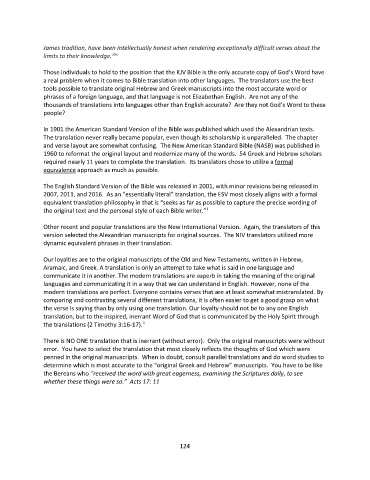Page 126 - Doctrine and History of the Preservation of the Bible revised
P. 126
James tradition, have been intellectually honest when rendering exceptionally difficult verses about the
xlix
limits to their knowledge.
Those individuals to hold to the position that the KJV Bible is the only accurate copy of God’s Word have
a real problem when it comes to Bible translation into other languages. The translators use the best
tools possible to translate original Hebrew and Greek manuscripts into the most accurate word or
phrases of a foreign language, and that language is not Elizabethan English. Are not any of the
thousands of translations into languages other than English accurate? Are they not God’s Word to these
people?
In 1901 the American Standard Version of the Bible was published which used the Alexandrian texts.
The translation never really became popular, even though its scholarship is unparalleled. The chapter
and verse layout are somewhat confusing. The New American Standard Bible (NASB) was published in
1960 to reformat the original layout and modernize many of the words. 54 Greek and Hebrew scholars
required nearly 11 years to complete the translation. Its translators chose to utilize a formal
equivalence approach as much as possible.
The English Standard Version of the Bible was released in 2001, with minor revisions being released in
2007, 2011, and 2016. As an “essentially literal” translation, the ESV most closely aligns with a formal
equivalent translation philosophy in that is “seeks as far as possible to capture the precise wording of
the original text and the personal style of each Bible writer.” l
Other recent and popular translations are the New International Version. Again, the translators of this
version selected the Alexandrian manuscripts for original sources. The NIV translators utilized more
dynamic equivalent phrases in their translation.
Our loyalties are to the original manuscripts of the Old and New Testaments, written in Hebrew,
Aramaic, and Greek. A translation is only an attempt to take what is said in one language and
communicate it in another. The modern translations are superb in taking the meaning of the original
languages and communicating it in a way that we can understand in English. However, none of the
modern translations are perfect. Everyone contains verses that are at least somewhat mistranslated. By
comparing and contrasting several different translations, it is often easier to get a good grasp on what
the verse is saying than by only using one translation. Our loyalty should not be to any one English
translation, but to the inspired, inerrant Word of God that is communicated by the Holy Spirit through
li
the translations (2 Timothy 3:16-17).
There is NO ONE translation that is inerrant (without error). Only the original manuscripts were without
error. You have to select the translation that most closely reflects the thoughts of God which were
penned in the original manuscripts. When in doubt, consult parallel translations and do word studies to
determine which is most accurate to the “original Greek and Hebrew” manuscripts. You have to be like
the Bereans who “received the word with great eagerness, examining the Scriptures daily, to see
whether these things were so.” Acts 17: 11
124

